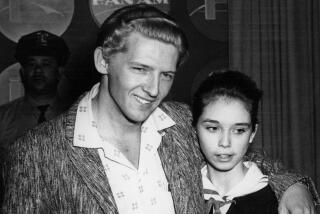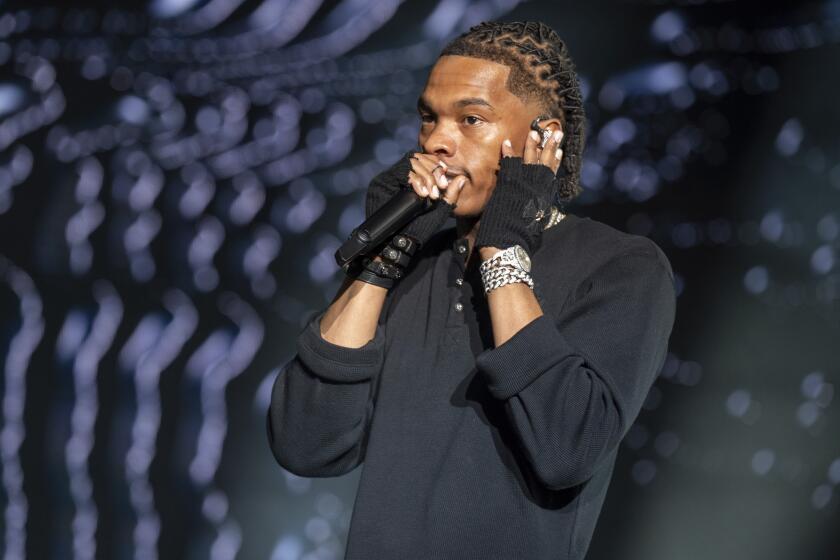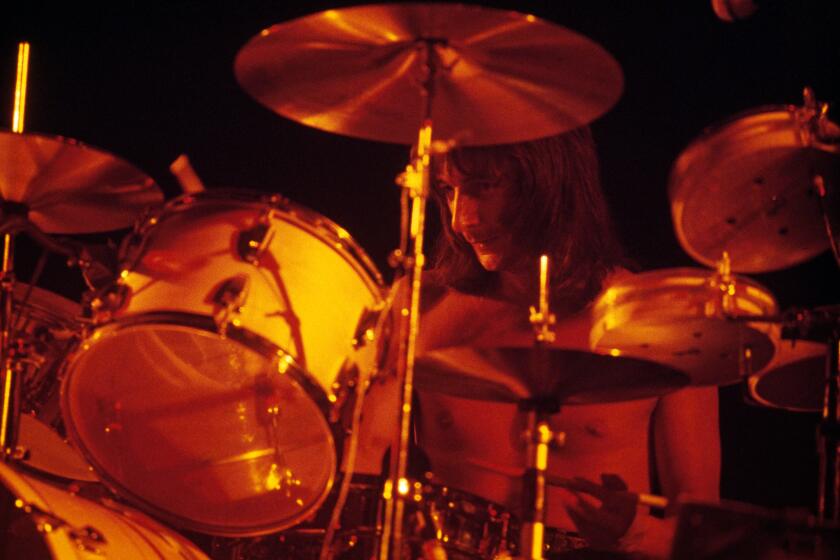COVER STORY : The Strangefruit Mission : Their sound is a strange brew of metal, punk, rap and hip-hop. What are these six women trying to prove? Nothing, except their right to bend the rigid definitions of jazz and to challenge the guys who rule that world
A confetti of sound drenches the northernmost stretch of Hillhurst Avenue. Jagged shards of notes--belligerent dissonance--interrupt Sunday’s rhythm. A messy line forms at the lip of the sidewalk, just in front of Art N’ Barbee’s, a folksy-cum-tony Los Feliz ‘cue joint, hidden from the street by a weathered wooden gate. At the entrance, a woman carefully pins small red bows--like a prom corsage--onto lapels of men and women in church linens, or to the grungy Ts of consciously mismatched bohos. Ears and eyes eagerly angle toward the sound, curious about what is fast whipping up into some sort of a sonic blizzard this warm afternoon.
From beneath a flower-adorned canopy springs the source of the raucous racket. Six African American women swing from free-form metal to sinewy hip-hop to their own turn of phrase in the language of jazz. Guitarist Maria Hobbs is shredding notes, her long brown ponytail swaying not in meter with the music but in time, it seems, with her own interior tone poem. Percussionist Evonne Williams, lost in overalls several sizes too big and with a bandanna controlling short dreadlocks, pounds out a complex rhythm thicket.
“You go , girls!” shouts a woman with a short, angular coif sitting toward the edge of the patio. She lifts a plastic glass of white Zinfandel in toast.
Alto saxophonist and leader Ngozi (Goz) Inyama looks toward the voice, then nods. This sisterly endearment makes them all smile. For a moment, instead of lyrics, there is laughter.
It’s an inside joke, a “girlene thang.” The word girl is loaded on the lips, taboo for Strangefruit, the L.A.-based sextet that fell together about a year and a half ago through a series of informal Inglewood garage-style jam sessions that served up everything from kinetic freestyle to warmed-over Motown. The term--and any variation on it from gals on down--gives them pause. As do the brotherly slaps on the back that the boys from the bands--mentors to their journeymen peers--offer with their effusive verdict at set’s end: “You’re pretty good for girls.”
Moorylien M. Jenkins, keyboards, 24; Jai Brooks, drums, 28; Tara Thierry, 30, bass; Williams, percussion, 27; Hobbs, guitar, 29; Inyama, 28, sax--all resemble the “girls” you’d pass on Berkeley’s Telegraph Avenue, the scruffy but self-confident ones in denim and Doc Martens (long before they made their way onto Nordstrom’s shelves) lingering outside of Rasputin Records, cracking open CD seals, impatient to devour the liner notes then and there.
For a little over a year, Inyama and crew have been proudly asserting their sonic wild style, circulating their demo tapes and playing at benefits (like the one at Art N’ Barbee’s) and cozy venues around the city, including Leimert Park’s World Stage and West Adams’ Club Fais Do Do. They’ve enchanted the university set and craftily infiltrated non-commercial airwaves as part of public radio station KCRW-FM’s evocative world mixes and can be found amid the edgy and unstructured playlist at Loyola Marymount University’s KXLU-FM. The ensemble prides itself on its “free-styling” approach to jazz’s standard repertoire. “We arrange tunes,” explains Inyama, “the way we feel them.”
From ambient childhood soundscapes that included fluttering flamenco guitars, Philly Soul horns on 8-tracks and the stately strut of New Orleans jazz (not to mention an occasional double shot of undiluted punk), Strangefruit has set out to create a fetching conflation of metal, punk, rap and hip-hop, and to spit it out with a heap of attitude.
Seattle’s grunge-rock-spawned and feminism-informed Riot Grrrls, whose counterculture anthems can be heard on disc or read in muddily reproduced, self-published ‘zines, have nothing on these self-assured women bent on reworking (and thus wreaking havoc with) the dusty lexicon of jazz. They are fast retooling that lexicon into what they call industrial jazz alternative hip-hop-- “not a fusion of,” they stress, but “an expression of” their wide array of styles and influences and moods.
For women, the locks on the rock world’s doors are pretty simple to spring, compared to access to even the fringes of the world of jazz. In the boom years, bop, post-bop and cool school combos only saw fit to let plush-lipped beauties grace the covers of the latest Blue Note or Pacific Jazz opus. And with the exception of torch singers who, when they weren’t sealed in sequins, sometimes sat behind a baby grand, the circumference of the spotlight remained the only real place of prominence. Aware of this history, the members of Strangefruit assure all who listen that they simply want to borrow a few accouterments in order to create a vast musical region of their own.
But the afterimage remains. Inyama knows this to be true. She sometimes reads it in the startled glimpses of club denizens when the members of the band pull instruments from their cases. She hears it in surprised hoots and hollers when at set’s end their musical voices bloom complex, distinct and assertive.
But their most loyal audiences, Inyama says, bask in the fluidity, the unexpected changes in pace and form: the way one might spin CDs by mood on a Saturday--from a Bach mass, to a Monk doodle, to a neo-Beat Generation meditation--Digable Planets-style. Strangefruit’s growing cult status and devoted followers of varying hues and musical penchants have surprised even the band itself. Everybody, says Williams, “from hip-hop artists all the way up to older jazz musicians and white liberals. I mean we have young cholos telling us that they love us . . . “
“And,” boasts Inyama, “that they want to tag our names.”
Sidestepping the inevitable pigeonholes eats up a lot of valuable time. These women squirm out of the grasp of labels as if they were steel shackles. The musical goals they have set for themselves require the utmost in discipline, keen ears and a nose for the new.
“The music maintains an integrity,” says Thierry, a native of Louisiana who attended jazz workshops in New Orleans with drummer Tony Williams and avant-garde saxophonist Kidd Jordan. “ . . . We get ready to play this straight-ahead tune, then we play this rock tune. . . . You can follow along with it, but it’s not like spoon-feeding pablum or something.”
“It’s why we sound the way we sound and why people can’t lock us down to either that or the other,” Evonne Williams explains. “Because everyone has their own personal music in their study background, a place where they feel most comfortable. We mesh it all together and make it Strangefruit.”
The band operates as a hothouse workshop, their practice sessions a laboratory to dissect hunches and fuse hybrids. They blur the lines of disciplines, of playlists. Like a radio that is stuck in scan mode, their music sweeps a wide range of possibilities: the ultra-smooth rap anthem “Bohemian Negritude” trumpets nonconformity backed by the steady cadence of African pride; “Maria Madness,” a hard-driving, thorny instrumental, is shot through with glinting mementos of guitarist Hobbs’ lengthy trail of rock avant-garde influences from guitarists Steve Vai to Mike Stern.
“Basically,” Thierry says, “we like anything that sounds real.”
There are echoes of eras and disparate environs strewn throughout their work--from the elegance of etudes to rap’s smug attitudes. Before Strangefruit, Williams, rapping since ‘79, had been angling toward a hip-hop career. Easing into a playlist that borrows more than just a pinch of jazz was a problem for her at first.
“I mean, the straight-ahead stuff is nice, but when I first got in the band, it was like, ‘Aw, I hate this stuff’ because I had never been there and it was kinda boring for me. (I felt) there was not a lot for me to do, but I’ve learned now that there is.”
For Thierry it has been a chance to move from abstracts to concrete: “It was really cool because I had done a lot of practicing and a lot of studying and hadn’t really been able to utilize the stuff,” she says, describing her musical proclivities as “outside.” “Learning how the bass interacts with the guitar and all of that, to me the purpose of the group is that we’re together to get better musically.”
With a sound that dramatically transforms from room to room, from straight-ahead to straight-up “out,” they’ve also found that seamless versatility has been both a hindrance and a blessing. Even free-form musical chameleons have to negotiate at least a modicum of democracy. Not everybody wants to play straight-ahead jazz all the time, nor does wandering the many chambers of deep house music meet with unanimous approval.
“It’s not necessarily jazz that we’re after,” Inyama finds herself persistently clarifying. “It’s all of that.”
The band’s sound perplexes scouts, hard-nosed club owners, and Tynant-sipping A&R; types, who would like to bottle the energy attractively but are at a loss as to how they can fully capture (and attractively market) its effervescence.
“First they say, ‘You guys sound great, but our marketing department is going to have a cow,’ ” Inyama says. “We may seem to be a marketer’s nightmare, but I also see it as a marketer’s challenge. They have to be that much more creative.”
Club dates, like the upcoming shows at 5th St. Dick’s on Wednesday and the Whisky on Thursday, keep the group buoyant as negotiations continue--Strangefruit is in and out of posh offices all over town.
There is a spec deal in the works with a production company that will pair the band with JMD of the band Underground Railroad (another outfit exploring that hip-hop-jazz conflation) for some studio time. There’s been talk as well about releasing a self-produced EP. “ ‘Cause,” Inyama says with a laugh, “we can’t get no love from the record company.”
Says World Stage manager Don Muhammad, who has observed the band’s steady growth: “They’ve developed very fast for a group as young as they are. Their following is amazing, mostly because they are able to blend their music so that it appeals to all ages--a little hip-hop, fusion, jazz. Because they are so diverse, I think they’ll go a long way. Their (popularity) grew out of the demand for that kind of group.”
And, he adds: “We’ve been bombarded with requests to bring in more women. And they made their presence known.”
In many ways Strangefruit is the logical extension of Generation X’s thirsty exploration of the many tone colors of jazz. The sextet is not so much a “nightmare” as an alluring patchwork: products of supermarket-style record stores, the lifestyle-in-a-bite look at the world via MTV and the wide span of public radio’s global reach, which brings music of remote worlds to our night table.
Hip-hop’s insatiable grazing through the ages is largely responsible for sending New Jacks and Jills feverishly raiding their parents’ disintegrating stacks of Verve LPs to locate those slammin’ samples. They aspire to add a note or two of urbane sophistication to their street-tough rhymes. But what makes Strangefruit’s row that much tougher to hoe are the politics of gender and a marketing machine that doesn’t know what to do with women (especially black women) who play the hell out of “non-traditional” instruments (horns and guitars) and don’t use sex to convey (read: sell) their message.
The female rocker has many a time stormed the stage in leather, guitars clanging. The Queen of Soul has seen at least a score--from balladeers to rappers--try for the crown. Neither sexpots nor coquettish vixens, Strangefruit, with its members’ dreadlocks, flattops and dusty work boots, occupies an orbit that no other local combo has traversed.
“They can’t make us another SWV or En Vogue,” Inyama says of the marketers. “They can’t put a 40-ounce (bottle of malt liquor) in our hands and put us in some miniskirts, and so they’re lost.”
Strangefruit is far from the first to attempt to storm that wall.
Some antecedents are not so difficult to trace: Billie Holiday, whose halting phrasing made famous the torch song from which the group takes its name, surreptitiously communicated her prowess through the arc and reach of an orchid-like voice.
Locating the trail to others is a bit more complex. Case in point: All-women ensembles like the traveling orchestra the International Sweethearts of Rhythm (formed in 1937 by Laurence Clifton Jones) were shadowed by the notion that it wasn’t just the critics who saw them simply as a flash-in-the-pan novelty: “The Duke and the Count took patronizing pleasure in the Sweethearts’ success,” Rosetta Ruitz wrote in her liner notes for the ensemble’s eponymous compilation released in 1984. “They sometimes watched from the wings and were happy” but more aptly surprised that “the sisters could cut it.”
In jazz hip-speak the term cut has a couple of weighty meanings. The first: to make the grade. The second: a challenge, to outdo. In their first year, the members of Strangefruit can already speak with a veteran’s experience about negotiating both interpretations.
In an Echo Park-adjacent rehearsal and living space, the women sit around the kitchen table playing dominoes, smoking cigarettes and trading war stories. Video games bleat in the background. Their instruments lie in a silent heap in another room.
“This guy I know was talking about some players,” Williams remembers. “He said: ‘Oh, those guys play like girls!’ And I said: ‘Thank you very much!’ Then he said: ‘No, but you guys don’t play like girls.’ Oh, we don’t? But we are.”
“I didn’t know that I went to a gender school of music,” Jenkins cracks.
Gearing up for another week of rehearsal and gigging around town, they most times try not to let the gender politics sweat them, and they are quick to say that the hurdles are certainly not exclusive to the world of music.
“It’s been tough to try and penetrate this predominantly male world--period,” Williams clarifies. “Whatever you do, no matter how good you are, there’s always going to be some jerk trying to shoot you down. In this business or any other.”
They’ve chosen not to give into the limits of convention. Still, those in the audience expect a voice, a singular woman’s voice, to take them through uncharted territory, bridging the changes. It is hard to break the mold of the sure-throated yet somewhat ethereal torch singer who fronts the band; Strangefruit doesn’t fulfill that fantasy. And with musical statements as sturdy as steel beams, these women are aiming to be hard as they come.
“They sang what I wanted to scream. That primal scream kind of thing,” says Natasha, an oboist and Juilliard graduate who has been long wandering L.A.’s sometimes indifferent club scene. “They’re fabulous . . . because you can’t put them in a box. As black women we express all kinds of stuff. I like Irish traditional music. I love rock ‘n’ roll, heavy metal, country-western, and as a black woman I’m told that I can’t do that. When I heard ‘Bohemian Negritude,’ I was jumping up and down in the kitchen with my broom . . . thought I was Mick Jagger.”
Their most enthusiastic and unconditional support has come from women. With Billie Holiday as spiritual guide, they assign other women prominent places in their paradigm for success. They hope to learn from Madonna’s business savvy and to possess the freshness and fortitude of the jazz “race women” who have preceded them--as well as those who are gigging in the trenches right alongside.
“There are a lot of women who are really excellent players, who have helped forge the path,” Thierry explains. “Natasha is one. (Bassist) Nedra Wheeler another. . . . Both of them really have been supportive and really helpful. The conversations--’Your sound is coming along.’ Nedra shoving her bass at me and telling me to sit in. Or Natasha offering suggestions about . . . ‘tightening it up here.’ All of that stuff is really helpful.”
But wrestling with the mechanics is only one very slim segment of the process. And the truth of the matter is that altering perceptions on the stage is oftentimes more difficult than off.
On a recent night the band is primed for a friendly jam session; ready, like any other set of young, hungry musicians, to find their way through the notes into the farthest reaches of a sinewy melody and ultimately embrace it, then finally make it their own. Yet when the instruments emerge, the women feel the steady gazes, the almost audible “Wait . . . let’s see . . . “ stare. A young man fronting the ensemble, no more than 21 or 22, begins the jam. The women follow the flow. An easy ride. But somehow, somewhere, they hit an unexpected snarl. Some dip in the darkness. Then another. They rise from some place out of notes in the blues hues.
Sometime afterward, somewhat rattled, the women huddle and reflect. They try their hand at reading minds.
“He had his vision,” Inyama says, “with or without our group.”
“It was just really controlling,” Jenkins says.
“Macho,” Williams quips. Then there is the laughter. The same sturdy laughter that sprinkled the patio at Art N’ Barbee’s.
A little bit ago that incident could have been a setback, a dangerously “stunting experience,” says Inyama, who is learning like the others to let those moments ride.
“Right now,” Thierry says, her soft voice rising, whittling it all down to basics, to what reigns supreme: “I’m just trying to hang with them changes!”
More to Read
The biggest entertainment stories
Get our big stories about Hollywood, film, television, music, arts, culture and more right in your inbox as soon as they publish.
You may occasionally receive promotional content from the Los Angeles Times.






